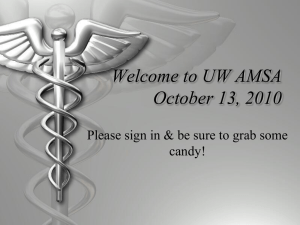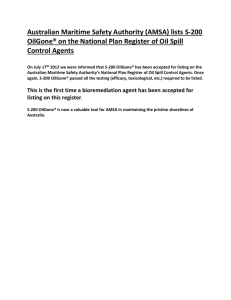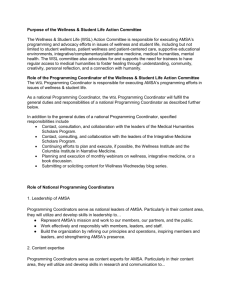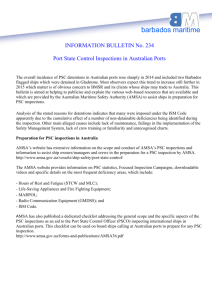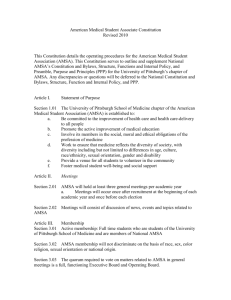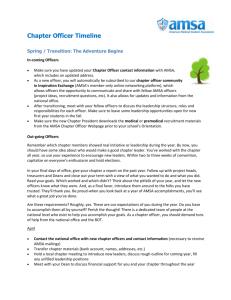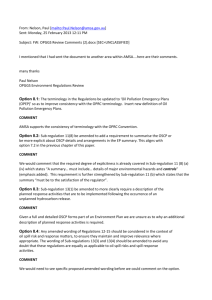989 KB - Department of Finance
advertisement
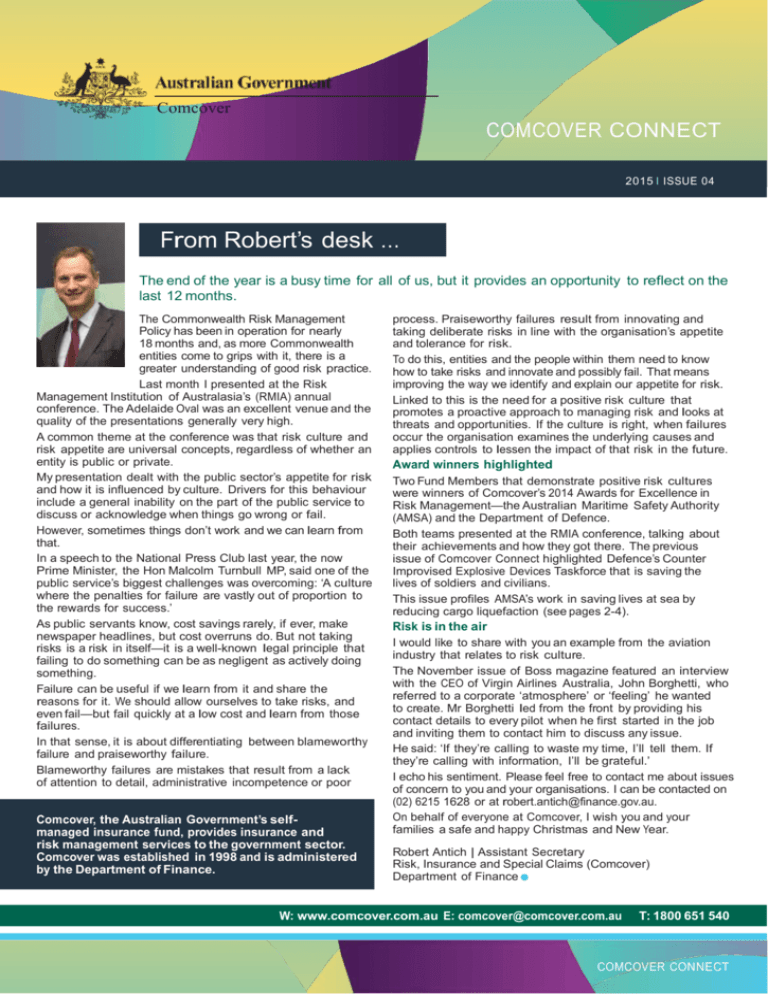
Comcover COMCOVER CONNECT 2015 I ISSUE 04 From Robert’s desk … The end of the year is a busy time for all of us, but it provides an opportunity to reflect on the last 12 months. The Commonwealth Risk Management Policy has been in operation for nearly 18 months and, as more Commonwealth entities come to grips with it, there is a greater understanding of good risk practice. Last month I presented at the Risk Management Institution of Australasia’s (RMIA) annual conference. The Adelaide Oval was an excellent venue and the quality of the presentations generally very high. A common theme at the conference was that risk culture and risk appetite are universal concepts, regardless of whether an entity is public or private. My presentation dealt with the public sector’s appetite for risk and how it is influenced by culture. Drivers for this behaviour include a general inability on the part of the public service to discuss or acknowledge when things go wrong or fail. However, sometimes things don’t work and we can learn from that. In a speech to the National Press Club last year, the now Prime Minister, the Hon Malcolm Turnbull MP, said one of the public service’s biggest challenges was overcoming: ‘A culture where the penalties for failure are vastly out of proportion to the rewards for success.’ As public servants know, cost savings rarely, if ever, make newspaper headlines, but cost overruns do. But not taking risks is a risk in itself—it is a well-known legal principle that failing to do something can be as negligent as actively doing something. Failure can be useful if we learn from it and share the reasons for it. We should allow ourselves to take risks, and even fail—but fail quickly at a low cost and learn from those failures. In that sense, it is about differentiating between blameworthy failure and praiseworthy failure. Blameworthy failures are mistakes that result from a lack of attention to detail, administrative incompetence or poor Comcover, the Australian Government’s selfmanaged insurance fund, provides insurance and risk management services to the government sector. Comcover was established in 1998 and is administered by the Department of Finance. process. Praiseworthy failures result from innovating and taking deliberate risks in line with the organisation’s appetite and tolerance for risk. To do this, entities and the people within them need to know how to take risks and innovate and possibly fail. That means improving the way we identify and explain our appetite for risk. Linked to this is the need for a positive risk culture that promotes a proactive approach to managing risk and looks at threats and opportunities. If the culture is right, when failures occur the organisation examines the underlying causes and applies controls to lessen the impact of that risk in the future. Award winners highlighted Two Fund Members that demonstrate positive risk cultures were winners of Comcover’s 2014 Awards for Excellence in Risk Management—the Australian Maritime Safety Authority (AMSA) and the Department of Defence. Both teams presented at the RMIA conference, talking about their achievements and how they got there. The previous issue of Comcover Connect highlighted Defence’s Counter Improvised Explosive Devices Taskforce that is saving the lives of soldiers and civilians. This issue profiles AMSA’s work in saving lives at sea by reducing cargo liquefaction (see pages 2-4). Risk is in the air I would like to share with you an example from the aviation industry that relates to risk culture. The November issue of Boss magazine featured an interview with the CEO of Virgin Airlines Australia, John Borghetti, who referred to a corporate ‘atmosphere’ or ‘feeling’ he wanted to create. Mr Borghetti led from the front by providing his contact details to every pilot when he first started in the job and inviting them to contact him to discuss any issue. He said: ‘If they’re calling to waste my time, I’ll tell them. If they’re calling with information, I’ll be grateful.’ I echo his sentiment. Please feel free to contact me about issues of concern to you and your organisations. I can be contacted on (02) 6215 1628 or at robert.antich@finance.gov.au. On behalf of everyone at Comcover, I wish you and your families a safe and happy Christmas and New Year. Robert Antich | Assistant Secretary Risk, Insurance and Special Claims (Comcover) Department of Finance W: www.comcover.com.au E: comcover@comcover.com.au T: 1800 651 540 COMCOVER CONNECT Risk management saves lives at sea The Australian Maritime Safety Authority (AMSA) has used a strategic risk management approach to improve shipping practices, helping to ensure Australia’s mineral exports are transported safely. AMSA’s work was recognised at the 2014 Comcover Risk Management Awards for Excellence where the entity won the risk initiative category. Australia is the largest exporter of iron ore, exporting about 613 million tonnes a year—half the world’s production. Australia relies almost exclusively on shipping to export mineral resources. The liquefaction of bulk-ore cargoes is an extreme risk that can occur during transportation when iron-ore fines come into contact with moist air or water. Combined with vibration, that results in a loss of cohesion between the ore particles. The ore changes its characteristics and acts like a liquid, potentially destabilising a vessel and causing it to capsize, often suddenly. From 2009 to 2013, 70 lives were lost and nine ships sank due to cargo liquefaction by a range of minerals, including iron ore. AMSA’s key priorities are maritime safety, protecting the marine environment and ensuring the safety of ships and crew—summarised in its vision statement: Safe and clean seas, saving lives. Recognising the challenges and risks of liquefaction of ironore fines, AMSA adopted a risk management approach to improve shipping practices to help ensure safe transportation of Australia’s major mineral exports. AMSA has taken a lead role to highlight the risk to the international maritime community; develop better testing, shipping and handling processes; and ensure the processes were implemented. AMSA identified critical concerns in addressing the problem: • Regulatory bodies disagreed on cargo properties. • There were no tests that could accurately determine if a particular iron-ore fine would liquefy and material properties were not understood. • Insurers applied their own requirements unilaterally to address perceived risk. • There was inconsistent application of ineffective controls by different countries. • Seafarers’ lives were being put at risk and fatalities were occurring. AMSA needed to convince the international maritime community of the need to recognise that iron-ore fines posed specific hazards when shipped; existing testing requirements were inadequate and burdensome; and there was an urgent 2 | COMCOVER CONNECT need to implement a new approach to protect lives. AMSA was aware that advancing changes to international maritime handling and shipping practices for mineral ores could take years. AMSA established a technical working group led by Australia and worked with the International Maritime Organization (IMO) Secretariat, insurers, industry bodies, international iron ore producers and critical member countries (Brazil being the most important) to develop a research and consultation path to build knowledge and identify effective controls. The research led to better understanding of the mechanics of liquefaction of mineral ores and development of a ‘real-world test’ that is accurate, reliable, and can be easily conducted on bulk-ore cargoes. AMSA mobilised an international team of stakeholders to build support for proposed changes with other administrations and persuade IMO to allow early implementation. The IMO Secretary General described the effort and activity to establish requirements for safe carriage of iron-ore fines as unprecedented. A key benefit of improved handling and transit processes has been the immediate enhancement of safety for seafarers and vessels. Only one ship carrying iron-ore fines has foundered since improved shipping and handling practices were adopted. The benefit to Australia’s resources sector is significant. The work has ensured 613 million tonnes of cargo has regulatory certainty at national and international levels. It has reduced uncertainty and costs associated with transport, including insurance premiums, ensuring a level commercial playing field for a vital Australian commodity and financial contributor to Australia’s economy. AMSA’s work has fostered a greater sense of cooperation between nations and increased cooperation between industry and the Australian Government. Industry stakeholders now have a greater understanding of IMO processes, how they can influence outcomes, and how they can support AMSA representations through technical, scientific, commercial and market research. Another major benefit is that research conducted during the project is relevant to all ore bodies shipped in bulk, such as coal and bauxite, ensuring greater risk mitigation and better safety and economic outcomes for countries that rely on the mineral resources sector. AMSA embarks on myth busting Myth busting was the key challenge for the Australian Maritime Safety Authority’s (AMSA) Ship Safety team when it embarked on a program to save lives by stopping ships sinking because of liquefaction of mineral cargoes. Alex Schultz-Altmann, AMSA’s Manager, Ship Inspection and Registration (Ship Safety), said in an interview with Comcover Connect, there was a common assumption iron ore was a ‘group C’ cargo—supported by its category in the mandatory International Maritime Solid Bulk Cargoes Code—which meant it was not subject to liquefaction. The assumption was wrong, but it was a complex process to dispel the myth. Mr Schultz-Altmann likens ore liquefaction to beach sand, which changes its properties the closer you are to the water line. ‘Iron ore is fine and granular when it’s dry. At the wet dry stage, it supports a lot of weight. Then, as the water pressure wells up, you sink and it moves easily.’ Simplistically, that is what can happen to iron ore when you add water. Its density changes, it liquefies and that can cause a bulk carrier to list or overturn. Iron ore’s propensity to liquefy was a surprise but, once the AMSA team understood that, it needed the science to prove it. Initially there was some industry pushback because of a fear of unnecessary over-regulation. Mr Schultz-Altmann and his team worked with industry to develop a ‘real-world test’ that could be calibrated against large-scale, detailed laboratory testing to determine the threshold moisture level (TML) and safe benchmarks to carry specific mineral cargoes. ‘We can discount cargoes that won’t liquefy and therefore do not need testing. For other ores, we err on the side of caution. The test is quite conservative,’ he said. ‘The TML tests are repeatable, we know it works, and we can prove it. It is almost fail-safe.’ The mineralogy of iron ore is assessed and, where necessary, it is now routinely tested to determine its TML before it goes into stockpiles awaiting shipment. While the process was developed, AMSA worked concurrently with members of the International Maritime Organization (IMO), with the assistance of Australian industry, to have the test and associated science accepted globally. At first, Brazil, another major iron ore exporter, was resistant. After discussions with AMSA officers Brazil agreed to a joint research programme and, once the science was verified by the Imperial College in London, the mood shifted from loggerheads to agreement, with active support internationally for the test and revised carriage requirements. ‘AMSA worked with the IMO on building a co-operative approach with stakeholders,’ Mr Schultz-Altmann said. It required more than just understanding the science; it had to be implemented in a practical way. ‘The international industry and governmental co-operative effort was quite spectacular,’ he said. After iron ore, the global co-operative approach moved to manganese ore, which was dealt with relatively simply and quickly. Coal was next with research indicating that of 105 Australian and international grades tested, only 14 posed no liquefaction risk. A greater number of coal exporters and varied coal blends mean the process is more complex than for iron and manganese ores. But Mr Schultz-Altmann is confident there will be a recommendation by September 2016 to change the IMSBC Code requirements for shipping coal. The recommendation would then go to IMO’s safety committee for finalisation. Ship owners’ mutual insurers, known as protection & indemnity clubs, are supporting the process and providing technical advice to regulatory authorities that are ‘struggling’. The environment is now a lot more collaborative than when the process started in 2012. The AMSA Ship Safety team’s next target is bauxite. On 1 January 2015, the Bulk Jupiter sank off the Vietnamese coast while transporting 46,400 tons of bauxite from Malaysia to China. Only one of the 19 crew was rescued. Mr Schultz-Altmann says not all bauxite is prone to liquefaction, ‘it depends on the material’s mineralogical properties, essentially what it’s mixed with’. Australia is one of the world’s largest shippers of bauxite but research has shown materials currently shipped from Australia do not have a risk of liquefaction. However, work is ongoing as other miners consider exporting. The AMSA team is gaining a greater understanding of bauxite and was successful, with the cooperation of international partners and industry, in having a correspondence group established at IMO to examine solutions to be presented at the IMO Carriage of Containers and Cargoes subcommittee’s next meeting. Mr Schultz-Altmann says industry has been very active and supportive in the process. Initial fears AMSA and its international partners were creating barriers to trade have been allayed by a realisation that understanding the risk (including being able to determine the TML of material) and putting controls in place makes ships safer, which saves lives and reduces the risk of higher insurance premiums. Despite having the backing of proven science, AMSA and other stakeholders had to engage in high-level diplomacy, which occurred at three levels: competent authorities, that is, the countries’ regulatory organisations that classify bulk cargoes and approve shipping methodologies; governmentlevel foreign affairs and trade portfolios; and industry engagement. ‘We needed to structure the message so it was the same at all three streams,’ Mr Schultz-Altmann said. He says a key factor in AMSA winning the risk management award was the speed with which it was able to achieve such a complex, global agreement. COMCOVER CONNECT | 3 Focus risk management on things that matter most Assessing risks from the ‘bottom up’ can sometimes be overwhelming, with more risks identified than can be effectively focused on. In this case study (see pp 2-3), AMSA has demonstrated the value of focusing on risks that most directly affect the potential achievement of the authority’s strategic objectives—the things that must go right. Maritime safety is a key AMSA priority, and exporting iron ore from Australia a key national economic focus. Identifying the potential for uncontrolled iron ore liquefaction as a standout risk to both those strategic priorities enabled AMSA to focus the appropriate effort and resources on the challenge. In doing so, AMSA tackled an issue of direct and immediate relevance to its vision: Safe ships, clean seas, saving lives. Stakeholder engagement Stakeholder identification is an important element of the ‘Setting the context’ step of the ISO31000 risk management standard. The increasingly interconnected and interdependent nature of government, society and the economy means few ‘big risks’ can be managed solely by an individual entity. International maritime trade is controlled by a complex network of international organisations, treaties and codes. AMSA demonstrated the value of early and structured identification of, and engagement with, stakeholders when dealing with complex and shared risks. Brokering and progressing within those arrangements was not straightforward, with many different working groups and national perspectives involved. AMSA worked to identifying the stance of various stakeholders, targeted individual stakeholders to maximise support, and mobilised support from industry in Australia and overseas. Measuring performance Risk management’s purpose is to achieve better outcomes and should be measured and tested to enable continuous improvement. AMSA was clearly able to demonstrate hard and soft outcomes from its risk management efforts. Most immediately, reduced shipping losses is a positive economic and human result. However, AMSA also improved the efficiency of related processes (avoiding the need for tripartite approval of arrangements for carriage of each cargo load), improved risk awareness and understanding in that area, and strengthened cooperation with industry and across government. 4 | COMCOVER CONNECT Managing employment practices liability claims Comcover hosted a discussion forum on employment practices liability (EPL) on 18 November 2015 at the National Portrait Gallery, Canberra. The event was well-attended, with most Fund Members represented. Robert Antich, Assistant Secretary, Risk, Insurance and Special Claims Branch, opened the event and emphasised the need for Commonwealth entities to involve Comcover early when managing EPL claims. He discussed the advantages of developing a relationship with Comcover and encouraged Commonwealth entities to manage employment liability risks proactively and systematically. Russell Williams, manager of the Gallagher Bassett claims team, discussed liability trends and themes, and outlined strategies senior managers and practitioners could use to reduce costs and better manage risks. Mae Gan, Senior Legal Counsel for the Commonwealth Scientific and Industrial Research Organisation (CSIRO), spoke about the significant benefits of working in partnership with Comcover to develop a joint strategy to manage EPL claims. She shared CSIRO’s experiences in implementing practical strategies, including procedures and training for educating CSIRO staff in dealing with employment practice issues. Tim McDonald, National Workplace Practice Leader at Moray & Agnew, provided the perspective of a legal service provider managing employment-related disputes on the Commonwealth’s behalf. He emphasised the need for entities to follow agreed processes in managing performance issues and the importance of accurate and clear record keeping. The final speaker was Barbara Deegan, former Commissioner of the Australian Industrial Relations Commission, Fair Work Australia and the Fair Work Commission from 1996 to 2014 and now a consultant with law firm Ashurst. As a long-serving and distinguished decision-maker, she provided a view ‘from the bench’, arguing that the Commonwealth could and should be held to high standards in conducting litigation and acknowledging the difficulty in managing unrepresented litigants. Comcover encourages all Commonwealth entities to involve Comcover as soon as possible in management of EPL claims. Early intervention can assist in developing a proactive joint claims management strategy, reducing the financial and resource impact on the entity. If you have any general questions about EPL claims, please contact Fleur Lamb, Director – Comcover Claims, on 1800 654 540. ATO to harness benefits of integrated information The Australian Taxation Office is reinventing itself to be a contemporary service organisation with ‘clients at the centre of everything’. Jodie Thomas, Executive Director, ATO Corporate, said implementing streamlined, modern governance processes was part of that journey and technology was critical to moving from being ‘clunky’ and ‘process rich’ to contemporary and agile. Ms Thomas is overseeing implementation of software system Protecht.ERM and brims with enthusiasm for the changes it is heralding at ATO. She told Comcover Connect she sees greater opportunities for process automation that extend beyond the initial goal of improved governance and risk management. ‘Our goal is to be more modern, holistic and transparent and to move up the value chain by focusing more on the value-add and less on routine activities that can be automated,’ she said. Before Protecht.ERM, governance and risk information was stored in silos—sometimes paper-based, sometimes in databases or Microsoft SharePoint. The goal was for information to be centralised and easily accessible. ATO conducted extensive market research, talking to product vendors, other government entities and large corporations to gather information. A common factor among the most efficient organisations was their use of information and governance software systems. Since making the decision to engage Protecht last July, ATO now has the first four business processes— financial assurance, internal compliance, quality, and risk management—in final testing or going live. Ms Thomas said implementation was iterative with more business processes planned. While ATO had modernised policies and processes over the past two years, ‘even the best processes are still disconnected if they’re on paper or in silos’. Technology was enabling ATO to be more effective, Ms Thomas said. Her aim was to see every paper-based governance function brought into a one-stop shop, she told Comcover Connect. The core driver for implementing Protecht.ERM was achieving ‘a lighter touch’ while maintaining key controls; improving governance; and providing better support for senior management. ‘You can’t underestimate the value-add of having information in one spot—it allows for a more informed discussion on risk, compliance and governance generally,’ Ms Thomas said. One streamlined function has seen ATO cut 80 per cent of a previously predominantly manual workload. ATO’s list of whole-of-government requirements currently contains 564 line items and must be continuously updated. Previously information was garnered from a share drive, paper documents and contact with central agencies. It is now locked into Protecht.ERM with variance lists quickly and easily accessible. Automation was making ATO ‘challenge how we do things’. ‘You have to communicate a function to build it electronically,’ she said. Protecht.ERM offers real-time reporting and customised dashboards. Ms Thomas says the system is easily revised if a configured module is not achieving its goal. Ms Thomas has a few suggestions for Fund Members contemplating installing governance, compliance and risk management software: • Overestimate the amount of communication and support needed during the roll out. Provide proper change management and support across the agency for all end users. • Don’t skimp on system testing. Over-budget the time needed and use the broadest range of people to test, from power users to those who are reticent with IT. • Have a productive partnership with the software provider, those who own the processes, and the end users. Invest time to get the tripartite relationship right. And Ms Thomas’s final word of advice is ‘use the integrated information you can now access—don’t just look at it’. Reducing red tape Implementing efficient risk information management systems can reduce red tape. The results from Comcover’s 2015 risk management benchmarking programme reported 63 per cent of Fund Members still used Microsoft Excel to capture, monitor and report risk information. Efficient management of risk data and information via software system Protecht.ERM enables Fund Members to focus more time and resources on decision making because routine work involved in managing risk, regulatory compliance, and detailed stakeholder incident and event reporting is automated and streamlined. Managing risks is more than just collecting risk data. Protecht.ERM’s risk analytics and reporting module is a key component of the system and can assist Fund Members to: • Produce highly sophisticated tabular reports and graphical dashboards that can be tailored by users with no need to revert to specialist IT teams or Protecht, enabling Fund Members to be self-sufficient. Once trained, users can configure the software to precise agency-specific needs and protocols. • Quickly and easily download reports and dashboards into PowerPoint, Excel or PDF formats at the push of a button. • Email reports and dashboards at scheduled times or on demand. Protecht.ERM has been IRAP assessed, and can store data to ‘protected’ security level. Protecht CEO Alf Esteban said Comcover had demonstrated foresight in realising that, with the changed environment generated by the Public Governance, Performance and Accountability Act, Fund Members needed a software solution that could help them achieve their risk management objectives and be implemented quickly. COMCOVER CONNECT | 5 Risk culture comes from the top By Grant MacKinnon and Matthew Fraser, Deloitte Elevating the conversation about managing risk is key to developing a positive risk culture in entities across the Commonwealth. A positive risk culture is evidenced when people instinctively do the right thing, particularly in new or challenging situations where policy direction and operating procedures may be unclear as to the right course of action to be taken. The Commonwealth Risk Management Policy defines risk culture as ‘the set of shared attitudes, values and behaviours that characterise how an entity considers risk in its day-today activities’. An entity’s risk culture is a subset of its organisational culture—specifically it influences the way people understand, consider, discuss and take appropriate action in relation to managing risk. A positive risk culture promotes an open and active approach to managing risk that considers both threats and opportunities. Challenges that face entities in developing positive risk cultures were discussed at the last of Comcover’s SES breakfast series and risk management forums for 2015. As part of the SES education programme, participants from workshops conducted this year came together to consider the challenges they faced in building positive risk cultures. The breakfast was followed by a Comcover forum with more than 80 risk practitioners attending. To assist in developing an unbiased view of the culture of entities across the Commonwealth, participants were invited to respond anonymously to a series of questions about their perceptions of their organisations’ risk cultures via hand-held wireless touchpads. The responses were not unexpected for entities where the risk conversation is beginning in earnest. about identifying impediments to a positive risk culture starts, it is then possible to systematically redesign and simplify an entity’s operational and risk management approach. Redesigning risk approaches requires innovation but, concurrently, an entity must have confidence the efficacy of risk management approaches is not undermined by change. When respondents were asked whether they agreed or disagreed with the statement ‘in my organisation there is a willingness to think differently and try new things’, only 41 per cent agreed. That demonstrates a need to understand the drivers of the perceived reluctance to innovate and develop targeted actions to overcome the challenges of innovation. Past events, including adverse media or ministerial attention, may often be a factor. It is concerning that 53 per cent of respondents disagreed with the statement ‘people challenge others constructively if they think they’re not doing the right thing’. That can undermine a positive risk culture because potentially damaging behaviour is not being called out in a way that is conducive to a climate of transparency. Only 51 per cent of respondents agreed with the statement ‘risk management concerns are discussed openly and honestly’, demonstrating further work needs to be done in assisting entities to develop positive risk cultures. Comcover acknowledges that, while the forum’s sample size was small, insights garnered highlight issues that face entities in understanding the importance of developing positive risk cultures. Asked whether risk culture was different to organisational culture, only 51 per cent of forum participants disagreed or strongly disagreed, meaning 49 per cent were unaware they were the same thing. That demonstrates the need for further conversations on the importance of considering an entity’s risk culture in the context of its organisational culture. Leadership is essential to drive a different approach. In any entity, the positive tone from the top must be consistently heard at all organisational levels. Events calendar 2016 In the forum, 53 percent of respondents agreed with the statement ‘leaders/supervisors tend to be cynical about risk and compliance policies, processes and procedures’. Comcover Risk Management Benchmarking Survey 2016 – 18 January to 4 March Even with strong risk awareness, cumbersome processes detract from a positive tone. Where there is a desire to streamline operations, it is critical that risk management processes keep pace with operational changes. SES Discussion Forum: Exploring risk appetite and tolerance – 10 March In response to the statement ‘the time required to complete risk management activities exceeds the value they add’, only 46 per cent of participants disagreed. That result is potentially concerning, however it provides an opportunity to find where problematic processes might exist and systematically address them. Once the conversation 6 | COMCOVER CONNECT January to March Seminar: Exploring risk appetite and tolerance – 10 March SES Workshop: A strategic perspective to managing risk – 30 March Battle of the drones – legal issues for high flyers By Sophie Dawson and Daniela Lai, Ashurst Drones have quickly progressed from being a science fiction-like futuristic concept to everyday devices available in electronic stores. They are increasingly used in domestic and commercial applications, and by government entities. There are still legal uncertainties with using drones and Commonwealth entities must be aware of potential implications of integrating the technology into their operations. Some key legal issues to consider include Civil Aviation Safety Authority (CASA) regulations for remotely piloted aircraft, surveillance and trespass laws, and privacy. CASA regulations CASA regulations restrict the operation of unmanned aerial vehicles (UAVs), such as drones. The restrictions apply to UAVs for purposes other than sport or recreation. The regulations include that: • UAVs must not be flown over restricted or prohibited areas without written approval from the relevant authority • UAVs must not be operated within 30 metres of a person not directly associated with operating the UAV • a person must apply for an area approval from CASA to be permitted to operate a UAV above 400 feet or less than three nautical miles from an airfield • UAVs must operate under 400 feet without area approval, given they meet all other CASA requirements • UAVs must not drop or discharge objects that pose a risk to aircraft, people or property • a person or company may only operate a UAV for hire or reward if they hold a UAV operators certificate • UAVs must only be operated at night once prior approval and training is sought. Breaches of the regulations can attract fines of up to $9000. Surveillance laws An ‘optical surveillance device’ is defined broadly in surveillance legislation in Victoria, the Northern Territory, Western Australia and New South Wales. In the NSW Surveillance Devices Act it is defined as ‘any device capable of being used to record visually or observe an activity’. So, if an entity uses a camera attached to a drone it is likely to be considered using an optical surveillance device and care is required to ensure compliance with applicable state and territory surveillance laws. Privacy Act 1988 (Cwlth) Drones used to take photographs in places where people are present may collect ‘personal information’, for example, images of people’s faces, for the purposes of the Privacy Act 1988 (Cwlth). The Act does not generally affect people using drones for personal or domestic reasons. The Act contains a ‘carve out’ for non-business activities of collecting personal information for personal, family or household affairs. Likewise, media organisations that have committed to privacy standards are exempted for ‘acts in the course of journalism’. However, organisations considered APP entities under the Privacy Act need to comply with the Australian Privacy Principles to the extent they apply. Trespass law There are issues about how the laws of trespass apply to drones. A cause of action for trespass to land can arise where there is intrusion into property. In LJP Investments v Howard Chia Investments (1989) 24 NSWLR 490, the NSW Supreme Court found trespass to airspace occurred where the interference was ‘of a nature and at a height which may interfere with any ordinary uses of the land the occupier may see fit to undertake’. However, it is doubtful the test for trespass into airspace would apply to drones. Justice Bryson, in Bendal Pty Ltd v Mirvac Project Pty Ltd (1991) 23 NSWLR 464, said activities above the surface of land that ceased to have a sufficiently close relationship with it would not be protected by the law of trespass. He cited an English case, Bernstein of Leigh (Baron) v Skyviews & General Ltd [1978] QB 479. It was an action of trespass for flying over a plaintiff’s land to take an aerial photo of a country house the plaintiff had offered to sell to the defendant. The court found the defendant’s flight over the property was not trespass because flying hundreds of feet above the ground did not interfere with the plaintiff’s use of the land. The issue of trespass into airspace by overflying aircraft has not been dealt with in Australia and it remains to be seen whether the courts would follow the Bernstein decision. Drones used to record activities on private property may require the occupier’s permission to lawfully film. Courts have recognised an implied licence to enter a property to approach the occupier to request permission to film but, without permission, filming on private land may be a trespass. Conclusion As use of drones increases in domestic, commercial and government operations it is inevitable someone will use a drone in a way that offends someone or causes a substantial loss. When that occurs, the courts will look to clarify the many uncertainties that exist for drone use. Comcover can provide risk management and insurance advice to Fund Members considering using drones or that have already integrated drones in their operations. COMCOVER CONNECT | 7 Using drones – a case study in good practice The ABC has introduced use of drones, or remotely piloted aircraft (RPAs), to capture news and programme footage. Using RPAs to gather news material is becoming increasingly common. The ABC says RPA technology offers a convenient, relatively low-cost aerial filming capacity, and there are situations where their use may be appropriate, for example: • pre-planned current affairs stories or documentaries • large public events • disaster zones, such as floods, cyclones and fires • civil unrest • stories where ground-based access is too hazardous • traffic stories • non-arena sporting events • stories that involve elements of investigative journalism • stories or filming landscapes in regional areas • searches for people lost on the coast or in the bush. Recognising the risks involved in using RPAs, the ABC has introduced a mandatory referral process with all RPA use to be approved in advance by designated staff in each ABC division. The ABC has taken a proactive approach to educate staff through training, developing guidance material and checklists, and providing practical advice on the regulations, surveillance laws and privacy and trespass considerations highlighted by Ashurst (see page 7). ABC staff do not operate RPAs in Australia. Instead the ABC engages external contractors that meet Civil Aviation Safety Authority requirements and the ABC’s additional operational and editorial demands. Trained and approved ABC news staff have operated small RPAs on some overseas assignments, such as covering the aftermath of Tropical Cyclone Pam in Vanuatu last March and the anniversary last April of the landing at Gallipoli in Turkey. A key element of the ABC’s operating procedure requires staff considering using RPAs to ask a series of questions to determine if a RPA is the most appropriate way to collect the material. • Will the material you expect to collect using a RPA add benefit to the story that you could not otherwise get? • Is there a safer, simpler way to collect the material? • Is the story significant enough to warrant aerial intrusion with a RPA? • Are the people using the RPA appropriately trained? • Do you have approval from the appropriate designated ABC person? • Are you legally able to use the RPA in the area; are you satisfied you will not break state-based privacy, trespass, and surveillance device laws? Are you aware these laws vary from state to state? • Is operating a RPA likely to cause alarm or distress to third parties in the area being filmed (that is, people who are not the subject of the story) or unduly invade their privacy? Implementing the guidelines and mandatory referral processes work to assist the ABC to effectively manage the risks involved in using RPAs. Keep staff safe overseas – free access to Travel Tracker International SOS Travel Tracker, part of Comcover’s overseas medical and travel assistance services, can give Fund Members valuable information about staff overseas. Travel Tracker has the ability to track and communicate with travellers using data exchange between International SOS and Fund Members’ travel management companies. Knowing the whereabouts of staff members, expatriates and travellers is particularly critical in times of crisis or after major events. Travel Tracker functions include: • Expatriate locator module: Ability to add expatriates or assignees’ locations. • Mobile check-in: Travellers and expatriates can send their locations via the membership app to Travel Tracker. • Building locator module: Ability to monitor the location of geo-coded buildings within the Travel Tracker website. • Two-way SMS: Ability to send and receive SMS to improve communications with travellers and expatriates. Users can review SMS responses to determine travellers who need emergency help and tailor the support they require. Access to Travel Tracker is included in Comcover annual premiums and is no longer a user-pays service. More information on Travel Tracker is available on the International SOS member portal. (www.internationalsos.com) To learn more about how to access Comcover’s services, email comcover@comcover.com.au or call 1800 651 540. Disclaimer: Comcover Connect provides general information for the benefit of Fund Members. Comcover does not guarantee, nor accept legal liability arising from or connected to, the accuracy, reliability, currency or completeness of any material contained in Comcover Connect. Fund Members are asked to evaluate the accuracy, currency, completeness and relevance of the material this newsletter contains for their purposes. Comcover Connect is not a substitute for independent professional advice and Fund Members should obtain appropriate professional advice relevant to their particular circumstances. 8 | COMCOVER CONNECT
